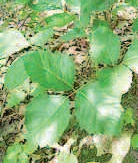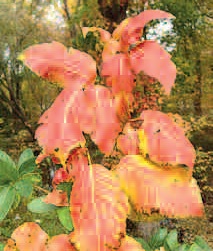Poison ivy: the itches of summer
by Roland D. Hallee
For some reason, this summer, I am getting more and more questions about poison ivy. Where is it? What does it look like? What do you do about it and how do you treat it?
All very legitimate questions.
As we all know, poison ivy and other members of its family can cause a lot of misery to humans should they make contact with the toxic plant.
Poison ivy, Toxicodendron radicans, is a member of the cashew family. It usually grows as a vine twining on tree trunks or crawls along the ground. It is generally found in all states in the United States east of the Rocky Mountains and southern Canada, specifically Québec, Ontario and Manitoba.

Poison ivy during summer
It may grow as a forest understory plant, although it is only somewhat shade tolerant. The plant is extremely common in suburban areas of New England. It can grow in many types of soil, and is not sensitive to soil moisture, although it does not grow in arid conditions.
The leaves of the poison ivy are red in the spring, turning to a shiny green later. Come fall, they turn yellow, red or orange. Each leaf is made up of three leaflets more or less notched at the edges. However, don’t let that be the determining factor. Some leaves have smooth edges. Two of the leaves appear opposite each other on the stem while the third one stands alone at the tip. Later in the season, clusters of poisonous, whitish, waxy looking berries will form.
Many people have difficulty identifying the plants because it can look like other plants, while, sometimes, other plants are mistaken as poison ivy.
Obviously, contact with the plant should be avoided. You can become infected simply by walking through the bush, taking off your shoes, and making contact with your skin.
Poison ivy in the U.S. is more common now than when Europeans first arrived in North America. The development of real estate adjacent to wild, undeveloped land caused the plant to spread into vast, lush colonies in these areas. Also, birds will eat the berries and transplant them on new areas along with their droppings. It’s also spread by other animals as the seeds remain viable after passing through the digestive system.

Poison ivy during autumn
A study by researchers at the University of Georgia found that poison ivy is particularly sensitive to carbon dioxide levels, increasing in numbers due to a higher concentration in the atmosphere. Poison ivy’s growth has doubled since the 1960s, and could possibly double again as the carbon dioxide levels continue to rise.
What do you do once you’ve made contact and develop a skin rash. There is some hope. Efforts to destroy these plants by uprooting or by spraying chemicals have been somewhat ineffective. Caution: whatever you do, do not burn the plant. Its toxins will filter into the air, and if breathed, can cause irritation in the lungs. Not a very pleasant experience.
The oil on the leaves is known as urushiol. The urushiol compound in poison ivy is not meant as a defensive measure, but rather helps the plant retain water. It is frequently eaten by animals such as deer and bears. Statistically, about 15 percent to 30 percent of people have no allergic reaction to the urushiol. Fortunately, I fall in that category.
Once contact has been made, it takes some time for it to penetrate the skin and do damage. Before this happens, it is wise to wash the skin completely several times with plenty of soap and water. Some experts say that washing within the first hour may help limit the rash. Care should be taken not to touch any other parts of the body, for even tiny amounts of the oil will cause irritation. Also, wash the clothing immediately. If poisoning develops, the blisters and red, itching skin may be treated with dressings of calamine lotion, Epsom salts, or bicarbonate of soda. Dermatologists recommend a simple oatmeal bath and baking soda as a possible remedy. Scientists have developed a vaccine that can be injected or swallowed. But this is effective only if taken before exposure.
So, now we know a little more about poison ivy. But, always remember this: “Leaves of three, let it be.”
Responsible journalism is hard work!
It is also expensive!
If you enjoy reading The Town Line and the good news we bring you each week, would you consider a donation to help us continue the work we’re doing?
The Town Line is a 501(c)(3) nonprofit private foundation, and all donations are tax deductible under the Internal Revenue Service code.
To help, please visit our online donation page or mail a check payable to The Town Line, PO Box 89, South China, ME 04358. Your contribution is appreciated!


Leave a Reply
Want to join the discussion?Feel free to contribute!